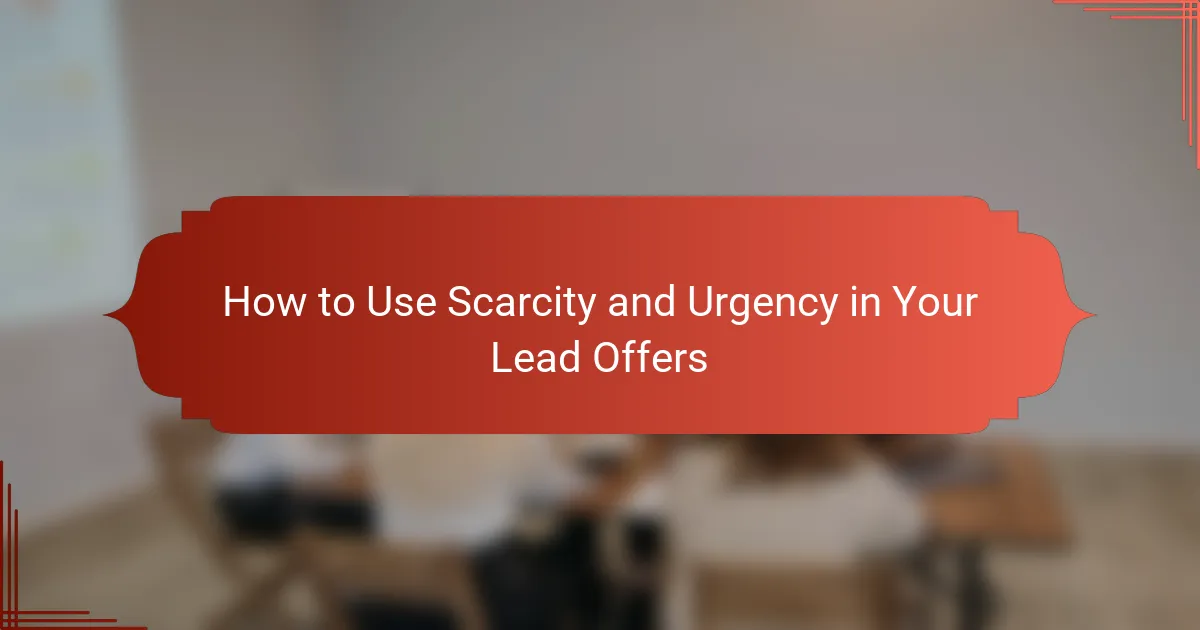Utilizing scarcity and urgency in your lead offers can significantly enhance your marketing effectiveness by prompting potential customers to act swiftly. By presenting limited-time promotions or exclusive deals, you create a compelling reason for individuals to engage before the opportunity slips away. This strategic approach not only fosters immediate action but also boosts conversion rates by instilling a fear of missing out on valuable offers.
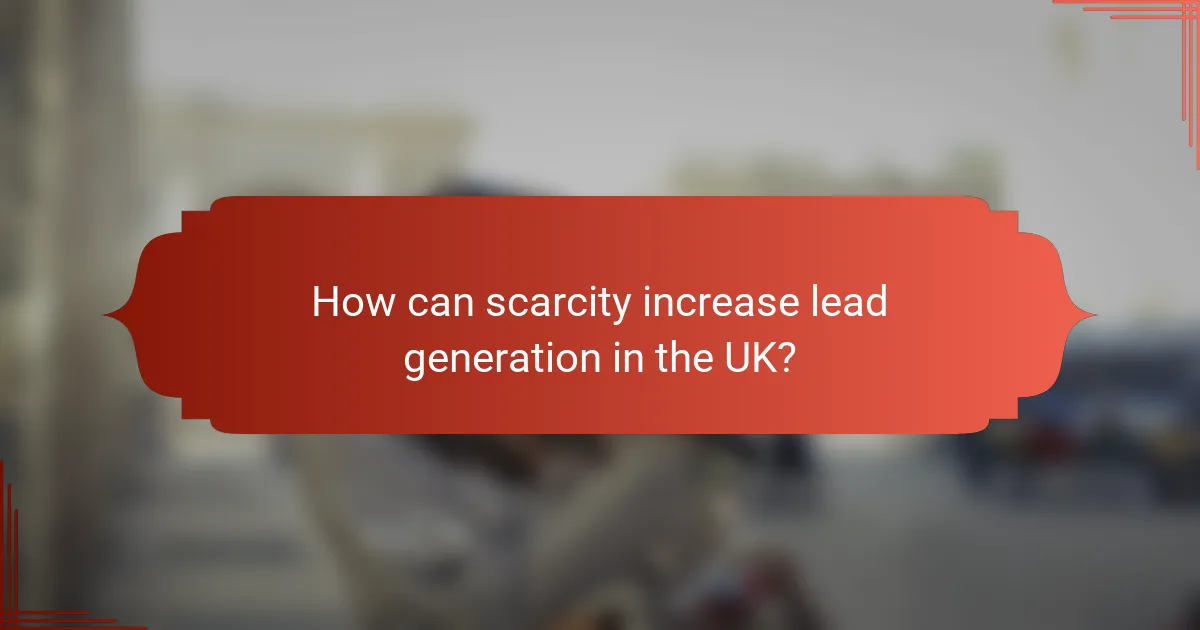
How can scarcity increase lead generation in the UK?
Scarcity can significantly boost lead generation in the UK by creating a sense of urgency among potential customers. When offers are perceived as limited, individuals are more likely to act quickly to avoid missing out.
Limited-time offers
Limited-time offers create urgency by setting a specific timeframe for potential customers to take action. For example, a discount available only for a week encourages quicker decision-making. This tactic can lead to higher conversion rates as customers rush to secure the deal before it expires.
To implement limited-time offers effectively, consider using phrases like “48-hour flash sale” or “this weekend only.” Ensure that the time frame is clear and visible on your promotional materials to maximize its impact.
Exclusive access
Offering exclusive access to products or services can enhance the perception of scarcity. For instance, providing early access to a new product for a select group can make those individuals feel special and more inclined to engage. This strategy not only drives leads but also fosters loyalty among customers.
To create exclusive access, consider membership programs or invitation-only events. Clearly communicate the benefits of exclusivity to encourage sign-ups and participation.
Countdown timers
Countdown timers are visual tools that display the remaining time for an offer, reinforcing the urgency to act. These timers can be placed on landing pages or in emails, providing a constant reminder of the time constraint. Research indicates that countdown timers can increase conversion rates by appealing to customers’ fear of missing out.
When using countdown timers, ensure they are prominently displayed and update in real-time. Consider using them for both limited-time offers and exclusive access promotions to amplify their effectiveness.

What are effective urgency tactics for lead offers?
Effective urgency tactics for lead offers create a sense of immediate action among potential customers. By leveraging time-sensitive promotions or limited availability, businesses can encourage quicker decision-making and increase conversion rates.
Flash sales
Flash sales are short-term promotions that typically last a few hours to a couple of days. These sales create urgency by offering significant discounts or exclusive deals that are only available for a limited time. For example, a retailer might announce a 50% off flash sale that lasts for just 24 hours, prompting customers to act quickly.
To implement a successful flash sale, clearly communicate the start and end times, and use countdown timers on your website and social media. This visual cue reinforces the urgency and encourages customers to make a purchase before time runs out.
Limited stock notifications
Limited stock notifications inform customers when an item is running low in inventory, creating a fear of missing out. Phrases like “Only 3 left in stock!” or “Hurry, limited quantities available!” can motivate customers to complete their purchases sooner rather than later.
Consider integrating these notifications on product pages and during the checkout process. However, ensure that the stock levels are accurate to maintain trust with your customers. Misleading stock information can lead to dissatisfaction and potential loss of future sales.
Urgency-based email campaigns
Urgency-based email campaigns leverage time-sensitive offers to drive immediate action from subscribers. These emails can include limited-time discounts, exclusive access to new products, or reminders about upcoming sales that emphasize urgency.
To maximize effectiveness, segment your email list and tailor messages to specific customer groups. Use compelling subject lines that highlight urgency, such as “Last Chance: 24-Hour Sale!” or “Only a Few Hours Left to Save!” This approach can significantly increase open and click-through rates, leading to higher conversions.
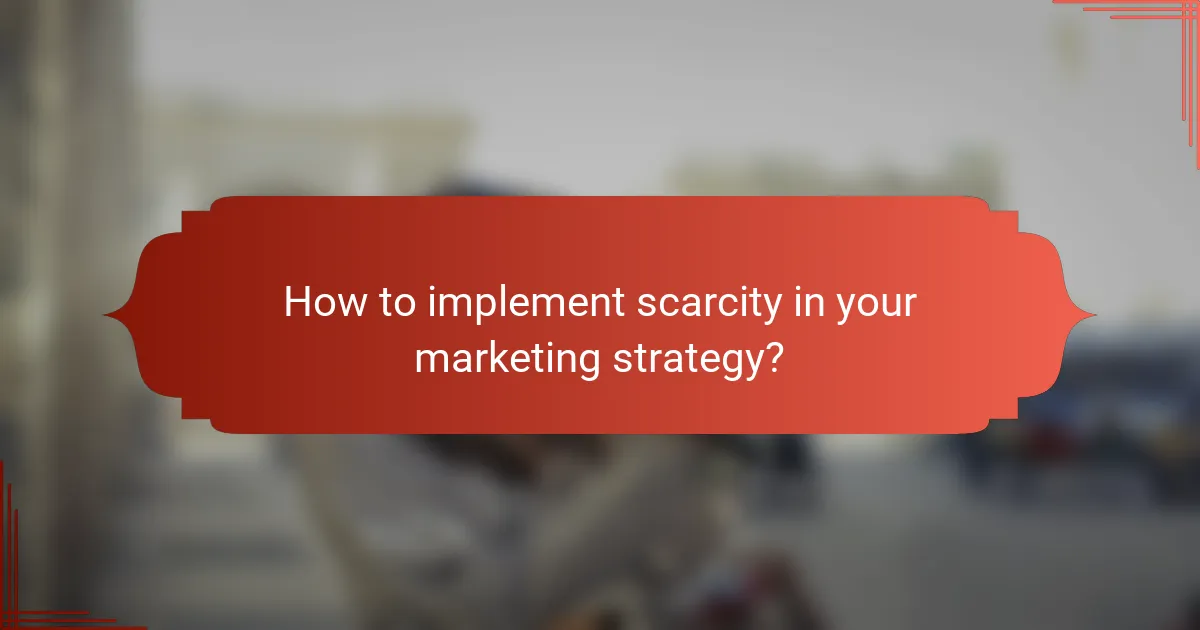
How to implement scarcity in your marketing strategy?
Implementing scarcity in your marketing strategy involves creating a perception of limited availability to encourage quicker consumer decisions. This can drive urgency and increase conversions by making potential customers feel they might miss out on a valuable offer.
Define your offer
Clearly defining your offer is crucial for effective scarcity marketing. Specify what is limited, whether it’s a product, service, or discount, and ensure that the value is apparent to your audience. For example, instead of saying “limited time offer,” specify “only 50 units available at this price.”
Consider using tiered offers to enhance the sense of scarcity. For instance, you could provide a special discount for the first 20 customers, creating urgency among potential buyers to act quickly.
Set clear deadlines
Setting clear deadlines is essential to reinforce the urgency of your offer. Specify exact dates and times for when the offer will expire or when the limited stock will run out. For example, “Offer ends at midnight on Friday” provides a concrete timeframe that encourages immediate action.
Additionally, consider using countdown timers on your website or in promotional emails. This visual cue can heighten the urgency and remind customers that time is running out, prompting them to make a purchase decision sooner.
Use persuasive language
Using persuasive language can significantly enhance the effectiveness of your scarcity tactics. Phrases like “act now,” “limited stock,” and “exclusive offer” can create a sense of urgency and compel customers to respond quickly. Make sure your messaging emphasizes the benefits of acting fast.
Avoid overused phrases that may come off as insincere. Instead, focus on genuine urgency by highlighting the unique aspects of your offer. For instance, “Only available for the next 24 hours” sounds more compelling than generic statements about scarcity.
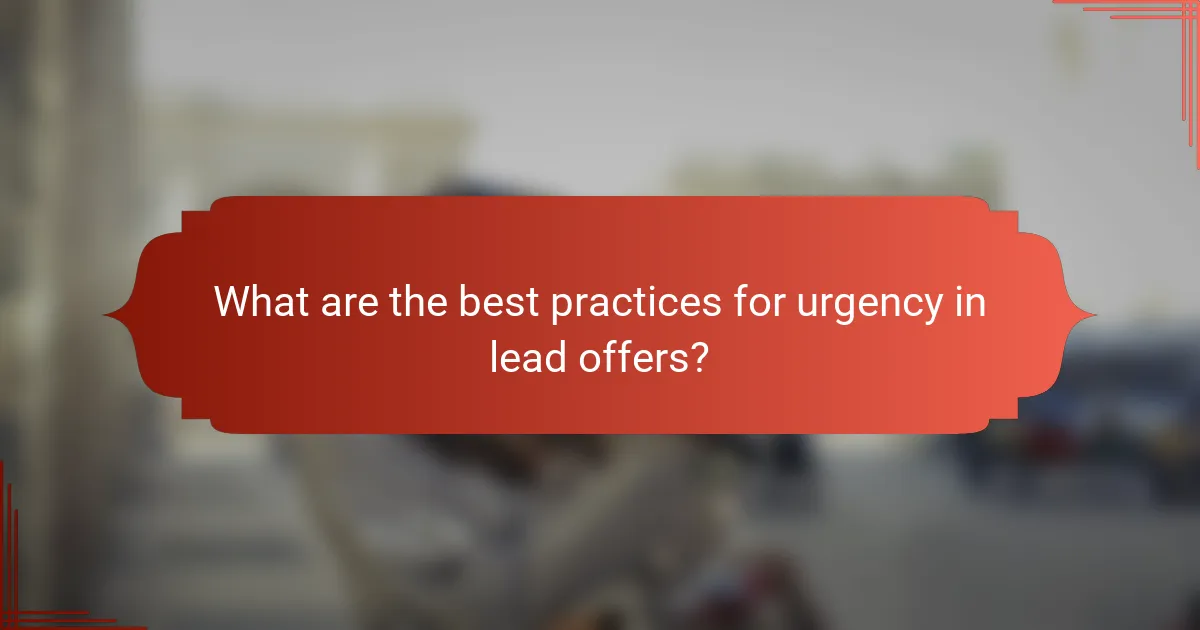
What are the best practices for urgency in lead offers?
Effective urgency in lead offers encourages potential customers to act quickly. Best practices include clear communication of limited-time offers, emphasizing scarcity, and creating a sense of immediate need.
Test different approaches
Experimenting with various urgency tactics can reveal what resonates best with your audience. For instance, try limited-time discounts, countdown timers, or exclusive access to new products. Each method can evoke different responses, so testing is crucial.
Consider A/B testing different messages or visuals to see which generates more conversions. You might find that a straightforward countdown timer performs better than vague language about limited availability.
Monitor customer response
Tracking customer reactions to your urgency strategies is essential for understanding their effectiveness. Use analytics tools to measure engagement rates, conversion rates, and overall sales performance. Pay attention to how quickly customers respond to offers.
Gather qualitative feedback through surveys or direct communication to gain insights into customer perceptions of urgency. This data can help you refine your approach and better align with customer expectations.
Adjust based on feedback
Be prepared to modify your urgency tactics based on the feedback and data collected. If certain messages or strategies are not performing well, consider revising them to better meet customer needs. Flexibility can lead to improved results.
For example, if customers express confusion about a limited-time offer, clarify the details or adjust the messaging to enhance understanding. Regularly revisiting your urgency strategies ensures they remain effective and relevant.
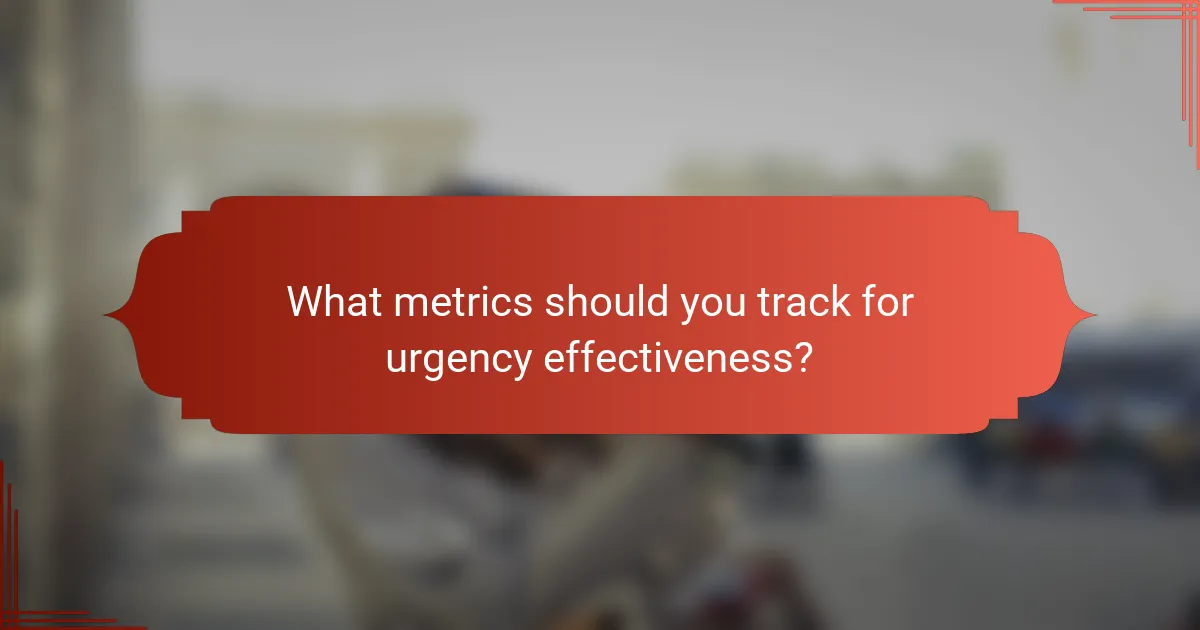
What metrics should you track for urgency effectiveness?
To measure the effectiveness of urgency in your lead offers, focus on key metrics such as conversion rates, engagement levels, and lead quality. These metrics provide insights into how well your urgency tactics are driving action and attracting valuable leads.
Conversion rates
Conversion rates indicate the percentage of visitors who take a desired action, such as signing up for a newsletter or making a purchase. Tracking this metric helps you understand how urgency influences decision-making. A well-implemented urgency tactic can often boost conversion rates by several percentage points.
To optimize conversion rates, consider A/B testing different urgency strategies, such as limited-time offers or countdown timers. Monitor changes in conversion rates to determine which tactics resonate best with your audience.
Engagement levels
Engagement levels reflect how actively users interact with your content or offers. High engagement often correlates with effective urgency strategies, as users are more likely to respond to time-sensitive messages. Metrics like click-through rates and time spent on page can provide valuable insights.
To enhance engagement, use compelling language that emphasizes scarcity, such as “only a few spots left” or “offer ends soon.” Regularly analyze engagement metrics to refine your approach and ensure your urgency tactics remain effective.
Lead quality
Lead quality measures how likely leads are to convert into paying customers. High-quality leads typically show greater interest and intent, making them more valuable. Tracking lead quality helps you assess whether your urgency tactics attract the right audience.
To improve lead quality, focus on targeting specific demographics that align with your ideal customer profile. Use urgency tactics that appeal to these groups, such as exclusive offers or early access to products, to attract leads that are more likely to convert.
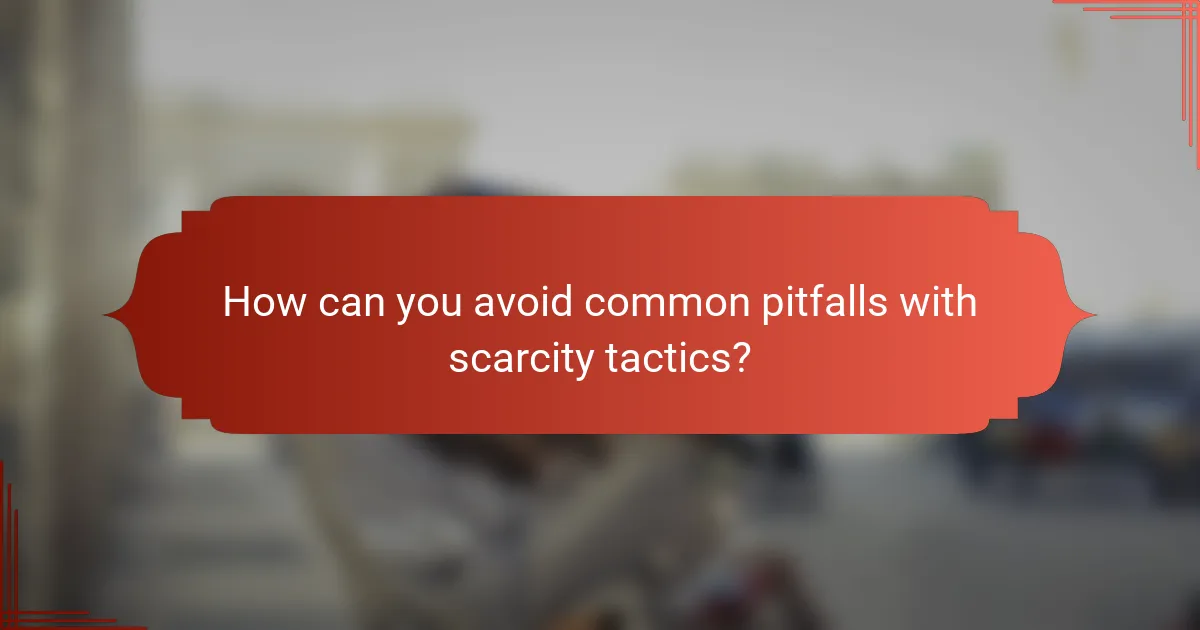
How can you avoid common pitfalls with scarcity tactics?
To avoid common pitfalls with scarcity tactics, ensure that your offers are genuine and not misleading. Authenticity builds trust, while exaggerated claims can damage your reputation and customer relationships.
Understand the difference between real and artificial scarcity
Real scarcity occurs when a product or service is limited in quantity or time, while artificial scarcity is created through marketing tactics that may not reflect actual availability. Understanding this difference is crucial; real scarcity can drive urgency and sales, while artificial scarcity can lead to customer skepticism.
For example, if you have only 50 items left in stock, that’s real scarcity. However, claiming that a product is “limited edition” when you plan to restock soon is an artificial tactic that can backfire.
Be transparent with your audience
Transparency is key when using scarcity tactics. Clearly communicate the limits of your offers, such as the number of items available or the time left for a promotion. This honesty not only fosters trust but also encourages customers to act quickly without feeling manipulated.
For instance, stating “Only 10 left in stock!” is straightforward, while vague phrases like “Limited time offer” may raise doubts. Always back up your claims with real data to maintain credibility.
Avoid overusing urgency
While urgency can be effective, overusing it can lead to desensitization among your audience. If every offer is framed as urgent, customers may begin to ignore your messages. Balance is essential; use urgency strategically for select promotions to maintain its effectiveness.
Consider limiting urgency tactics to special sales or exclusive events. For example, a seasonal sale with a countdown timer can create excitement, while constant urgency may dilute its impact.
Test and analyze your tactics
Regularly testing and analyzing your scarcity and urgency tactics is vital for understanding what resonates with your audience. Use A/B testing to compare different approaches and gather data on customer responses.
For example, you might test two versions of an email campaign: one emphasizing scarcity and the other focusing on value. Analyze which version leads to higher conversion rates and adjust your strategies accordingly.
